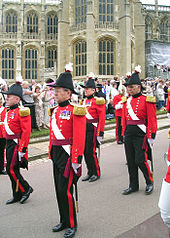
The Military Knights of Windsor, originally the Alms Knights and informally the Poor Knights, are retired military officers who receive a pension and accommodation at Windsor Castle, and who provide support for the Order of the Garter and for the services of St. George's Chapel, Windsor Castle. They are commanded by a senior retired officer as Governor of the Military Knights of Windsor.
History
The Alms Knights of St. George's Chapel were constituted by King Edward III following the Battle of Crécy (1346), when many knights captured by the French were forced to liquidate their estates to raise ransom money in order to secure their release. At the original establishment of the Order of the Garter and its chapel at Windsor (1348), veteran warriors were called to "serve God continually in prayer". In the statutes of the College of St. George's, a community of twenty-six bedesmen, called Alms Knights or Poor Knights, were appointed. Their duties included attending four services per day and praying for the sovereign and the knights of the Order of the Garter.
The Alms Knights were a chantry, a religious foundation organised to pray for its patron. Poor Knights were originally impoverished military veterans. They were required to pray daily for the Sovereign and Knights Companions of the Order of the Garter; in return, they received 12 pennies per day and 40 shillings per year, and were lodged in Windsor Castle. Poverty was an important attribute of bedesmen, and indeed if any Poor Knight were to acquire assets with annual income of £20 or more, he would be removed from the college.
King Henry VIII halved their number to thirteen and Elizabeth I re-founded the order in 1559. At his restoration, King Charles II increased the number to eighteen. King William IV renamed them the Military Knights of Windsor in 1833.
Today, the Military Knights, who are no longer necessarily poor but are still military pensioners, participate in the Order's processions, escorting the Knights and Ladies of the Garter and attending the daily services in St. George's Chapel. They are not members of the Order itself, nor are they automatically a knight of any chivalric order.
Governor
The office of Governor of the Military Knights of Windsor is part of the Royal Household of the Sovereign of the United Kingdom, and dates from the mid-sixteenth century. Since 1905, the role has been controlled by the Constable of Windsor Castle, having formerly been responsible to the Dean of Windsor. Since 1906 the Governor has always been a senior retired officer.
List of governors of the Military Knights of Windsor
| This list is incomplete; you can help by adding missing items. (December 2018) |
- c.1583: John Moulsworth (Mowlesworth) of Helpston, Northamptonshire (now Cambridgeshire): will dated 7 August 1583, Proved PCC 18 July 1584. Buried at St John the Baptist, New Windsor 2 September 1583
- to 1771: Sir William Wittewronge
- c.1820: Colonel Thomas Bassett
- 1842: Captain John Jonstone Cumming
- 1843: Major Charles Moore
- 1843–1844: Captain Thomas Fernyhough, who died after 6 months in office. He was the first person to be buried in the catacombs beneath St George's Chapel.
- 1867: Major Sir John Paul Hopkins
- 1892: John Douglas Sutherland Campbell, 9th Duke of Argyll
- 1906: Major General Edward Henry Courtney
- 1913: Major General Walter Carteret Carey
- 1932: Lieutenant-General Sir Charles Kavanagh
- 1951: Major General Sir Edmund Hakewill-Smith
- 1978: Major General Sir Peter Gillett
- 1989: Major General Sir Peter Downward
- 2000: Major General Sir Michael Hobbs
- 2012: Lieutenant General Peter Pearson
External links
![]() Media related to Military Knights of Windsor at Wikimedia Commons
Media related to Military Knights of Windsor at Wikimedia Commons
- History from St. George's Chapel
- The Military Knights of Windsor, 1352-1944. Historical monographs relating to St. George's Chapel, Windsor Castle Volume 4. Edmund Fellowes (1944)
References
- ^ St. George's Chapel Archives and Chapter Library, "Military Knights", Research Guide No. 2
- "College of St George - Windsor Castle - St George's Timeline". Archived from the original on 28 September 2012.
- "College of St George - Windsor Castle - Military Knights". Archived from the original on 10 May 2010.
- The Military Knights of Windsor, 1352-1944. Historical monographs relating to St. George's Chapel, Windsor Castle Volume 4. Edmund Fellowes (1944)
- PROB 11/67/254
- The Windsor and Eton Express 15 January 1842
- 9/1/1844 and 16/1/1844 in the London Standard, The Colburn's United Service Magazine 1844
- "COURTNEY, Major General Edward Henry", Who Was Who
- "CAREY, Maj.-Gen. Carteret Walter", Who Was Who
- "Walter Carteret Carey". National Portrait Gallery.
- "Community News" (PDF). The Companion. p. 17. Archived from the original (PDF) on 8 August 2014. Retrieved 23 July 2014.
51°29′0″N 0°36′28″W / 51.48333°N 0.60778°W / 51.48333; -0.60778
Categories: